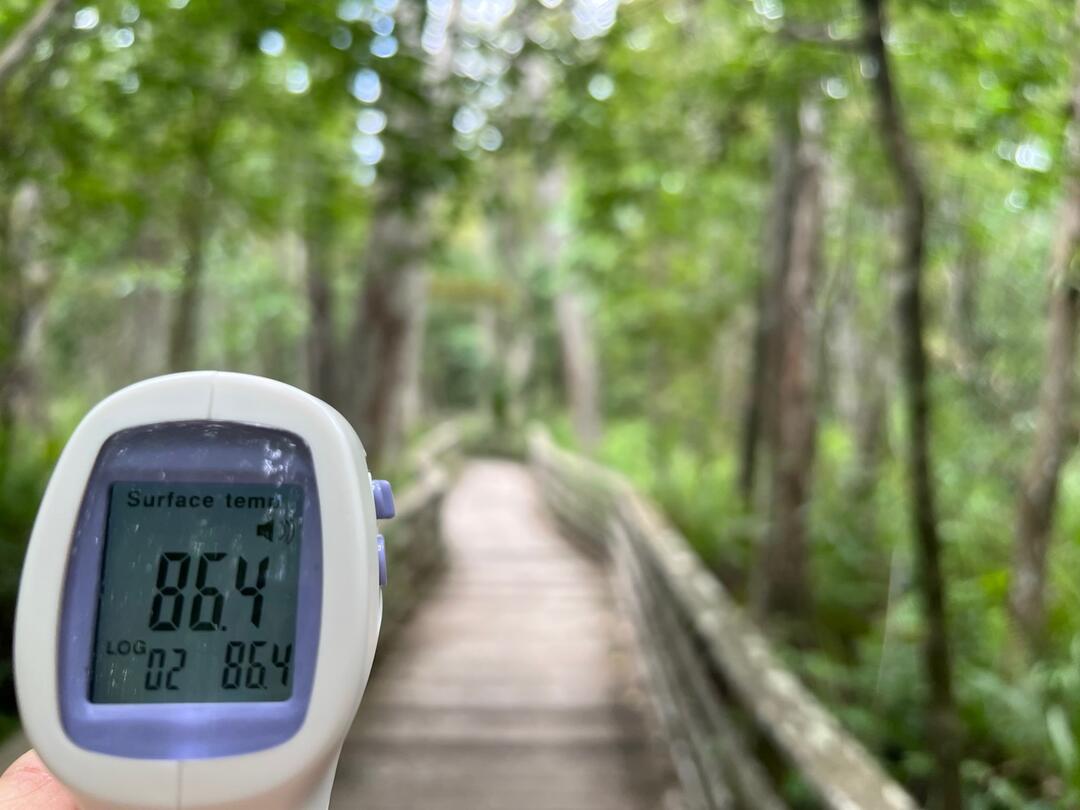With July 2023 ranking as potentially the hottest month ever recorded, the Audubon Florida team has gotten creative to ensure the safety and comfort of volunteers, visitors, residents, and fellow staff. Our staff and volunteers are our most precious resource, and with so many members of the team working outdoors on a regular basis, keeping everyone hydrated and protected from the sun is an important challenge.
The Everglades Science Center (ESC) in the Florida Keys is bearing the brunt of the heatwave, with water temperatures in Florida Bay reaching a steamy 96.7 degrees. The team is taking it slow in the field, listening to their bodies, and stocking up on Gatorade.
“We have been regularly reminding our crew of the dangers of heat exhaustion and encouraging them to take more water with them every day,” says ESC senior biologist Alex Blochel.
Especially because field work takes staff members far away from the mainland, ECS managers provide plenty of sunscreen, sun shirts, hats, and buffs for staff to stay safe.
On Florida’s beaches, sea and shorebirds are raising their families and often escape the heat right at the shoreline. Summer is when it is most important for our shorebird stewards to have a presence at the beach. They protect nesting sites and educate visitors about the need to give nesting birds their space. In this heat, however, program managers are having to encourage eager volunteers to limit the number of shifts they take on, even asking some to stay home to rest when they’ve been out for multiple shifts. Providing a shade tent is not only helpful for staff and volunteers, but also gives visitors an extra excuse to stop in for a peek at baby birds through the spotting scope.
At Corkscrew Swamp Sanctuary in Naples, visitors flock to the cypress swamp, one of the coolest places in town. But to get there, it is necessary to trek through the pine flatwoods and wet prairie, where temperatures are higher in direct sun. While on her boardwalk shift at the Sanctuary on July 21, volunteer naturalist Robbie Wooster used a handheld thermometer to record the temperature at various locations. Within a 20-minute window, she found the difference between the sunny wet prairie and shady cypress swamp to be a whopping 30 degrees!
“The swamp always feels so much cooler when you enter it, and now I know for sure,” says Wooster, who has her own routine for handling the heat. It includes soaking a bandanna with water and placing it across her neck, drizzling water into her hair, and staying in the shade as much as possible. When she gets back into the classroom for lunch, she puts frozen water bottles in each armpit for a complete cooldown. Also in the classroom, volunteers are treated to free electrolyte packets, and for two weeks the Sanctuary provides free ice cream sandwiches and popsicles for all volunteers on duty in honor of National Ice Cream Day on July 16.
Colorful signs reminding everyone to “Stay Hydrated!” have been installed inside the Blair Visitor Center and at the entrance to the boardwalk. Meanwhile, boardwalk repairs have been temporarily reduced to emergency repairs only, while many outdoor tasks such as mowing, digging, and exterior building work are only being scheduled early in the morning hours.
What do birds do when it is so hot? In the wild, many take refuge in shade trees during the hottest parts of the day. But at the Center for Birds of Prey in Maitland, staff take extra precautions to make sure the raptor residents are not overheating. Aviaries have sprinklers or misters and our residents in the garden get showers each day (sometimes twice). In fact, volunteers are charged with implementing unique ways to keep resident birds cool, like putting ice blocks in their enclosures to play with. Center volunteers are also encouraged to take advantage of free ice pops and water bottles.






